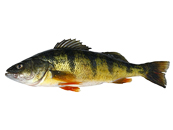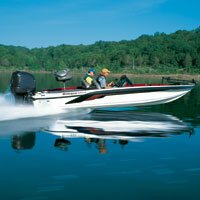Yellow Perch
Perca flavescens
AKA: Yellow ned, ned
-
Distinguishing Markings:
The general coloring tends to be brassy green to golden yellow on their sides and white to yellow on their belly. Their most distinguishing feature is 6 to 8 dark vertical bands found across their back and sides. The body is elongate and moderately compressed and their upper and lower jaws form the extreme anterior of the head. Their anal, pelvic, and pectoral fins are red to orange, with these colors being brightest in males during the spawning season. These fish are also characterized by having a dorsal fin that is completely divided into a spiny portion and a separate soft-rayed portion. Their anal fin features two long and slender spines. When the yellow perch is threatened, it will raise its spiny fins to inflict injury on the predator and protect itself.
-
Size:
Yellow perch can reach a maximum size of 18 inches.
-
Distribution:
On the Atlantic coast, yellow perch range from South Carolina north to Nova Scotia. They can also be found west through the southern Hudson Bay region to Saskatchewan, and south to the northern half of the Mississippi drainage, Iowa, Kansas, Illinois, Indiana, and even Utah.
-
Habitat:
Adult yellow perch inhabit slow-moving, nearshore areas where moderate amounts of vegetation provide cover, food and protection. Larval yellow perch will remain in the tributaries, but will generally migrate offshore to reduce their risk from predators. As juveniles, they learn how to avoid predators and move back to the shorelines to feed on the richer, nearshore food sources.
-
Food Preference:
Adults feed on insect larvae, crustaceans, and small fish, depending on the forage base available. Larval yellow perch feed on zooplankton and other tiny aquatic organisms.
-
Spawning:
In late winter and early spring, adult yellow perch migrate to the upper regions of rivers and tributaries to find suitable spawning habitat. Adults migrate shoreward into the shallows of impoundments and often into tributary streams to spawn. When living in brackish waters, males tend to reach the freshwater spawning areas first and do not migrate downstream until the females leave. When females arrive, they lay their eggs in large gelatinous strands, usually suspended from some type of structure or organic debris. Multiple males fertilize the eggs which hatch 11 to 27 days after fertilization, depending on water temperature. Males reach sexual maturity between ages 1 and 3, and female yellow perch mature between ages 2 and 3 and can produce between 5,000 and 109,000 eggs. Yellow perch are known to live as long as 13 years.
-
Fishing Tips:
For many anglers, yellow perch are the first fish to "arrive" in the rivers after the first of the year. Most fish are caught in these early winter months during their spawning run in the upper tributaries where they are easier to catch. During the rest of the year, they inhabit a vast territory, a wide variety of habitats, are a schooling fish, and congregate near shore in the spring. They are also taken recreationally, mainly because of their flavor and their desire to take a baited hook. Since yellow perch are most active during the daytime, fish during daylight hours to increase the odds of catching one. Another tip relates to the bait and lures to use for catching yellow perch.
See Also:
- Secret Fishing Tips
- Bass Fishing Tips - 10 Bass Fishing Secrets from the Pros
- 27 Ways To Tell If You’re A Fishing Fanatic
- Trolling Motors
- When To Fish
- Fighting A Fish
- Freshwater Fishing Tips
- Codes of Angling Ethics
- Freshwater Fishing Basics
- Fishing With Kids
- Where Do Fish Live?
- Discover Fishing
- Fishing Tips - Rod Storage
- Fly Fishing Boats
- What’cha Eating? Bait Matrix
- Flyfishing Essentials
- Freshwater Fish - Bass
- Ten Tips for Clean and Green Boating
- Finding the Right Freshwater Fishing Boat for You
- Freshwater Fish - Trout
- Freshwater Fish - Crappie
- Freshwater Fish - Northern Pike
- Fishing Accessories - Tips from the Boating Guy
- Freshwater Fish - Perch
- Choosing the Most Effective Freshwater Fishing Tactics
- Freshwater Fish - Catfish
- Freshwater Fish - Carp
- Selecting Your Freshwater Fishing Gear
- Freshwater Fish - Chain Pickerel
- Freshwater Fish - Walleye
- Freshwater Fish - Eel
- Freshwater Fish - Muskellunge
- Freshwater Fish - Drum
- Boating is Affordable


